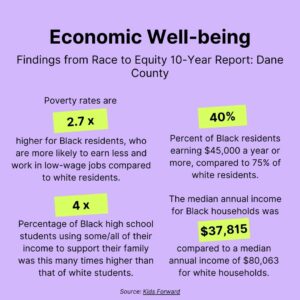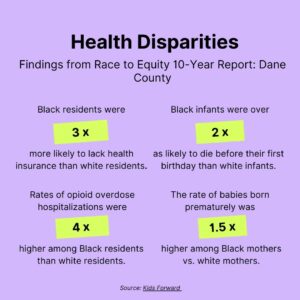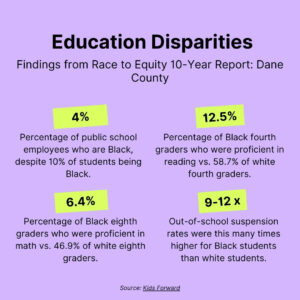‘Race to Equity’ report catalogs ‘extreme’ racial disparities in Dane County -Isthmus
Black residents of Dane County still far behind in ‘Race to Equity’ -The Cap Times
Black Dane County residents face ‘profound and persistent’ racial disparities, report finds -The Daily Cardinal
‘Alarming’ racial disparities continue to plague Dane County -Wisconsin State Journal
At first glance, the most surprising thing about these headlines is the extreme racial inequality in Dane County that they are alluding to.
But, in fact, the most startling thing is that two of them are from 2013, and two are from 2023.
In 10 years, the headlines have not changed. And while Madison and Dane County continue to be named among the best places to live in the country, Wisconsin has been described as one of the worst states for Black people to live.
In 2013, the progressive image of Dane County was challenged after a report unveiled concerning inequalities between Black and white residents that surpassed state and national levels. The data showed severe and persistent inequalities in employment, income, wealth, education, criminal justice, health and child welfare.
The results of “Race to Equity: A Baseline Report on the State of Racial Disparities in Dane County” were not surprising to many Black residents who have lived this reality. In fact, many of these residents have been calling attention to the disparities for years. Nevertheless, the data helped to establish that these disparities did indeed exist, capturing the attention of community members, as well as city, county and state officials.
In October, Kids Forward released its “Race to Equity 10-Year Report: Dane County.” The results showed that, a decade after the initial report, significant racial gaps persist in areas such as health, education and economic well-being, sparking more disappointment than surprise across the county. While Dane County is the fastest growing county in the state, its Black residents are not experiencing the same growth, prosperity and economic benefits as white residents. One city-level initiative, the Racial Equity and Social Justice Division, has made moderate progress toward community equity, but state-level policy change is needed.
The City’s Response
Race to Equity is an initiative of Kids Forward, a statewide policy center advocating for children and families of color in Wisconsin, previously known as the Wisconsin Council on Children and Families. Its 2023 update calls for specific solutions and ultimately raises questions about what progress, if any,has been made in the community.
In Mayor Satya Rhodes-Conway’s statement following the report’s release, she said the City of Madison must do better, while also pointing to the limited ways in which it can address the disparities.
“Our ability to address the inequities created by past and continuing structural racism is greatly impeded by state laws that prohibit Madison from taking many of the measures called for in the report,” the mayor said. “The city cannot enact a local living wage ordinance, cannot require paid sick days and cannot protect tenants’ rights.”
Indeed, many of these solutions are unattainable without state policy change. According to Carte’cia Lawrence, a senior racial equity policy analyst at Kids Forward, state preemption prevents local governments from increasing their minimum wage, a measure that could benefit Black residents in Dane County and elsewhere in Wisconsin.
Not long after the release of the 2013 report, the City of Madison formed the Racial Equity and Social Justice Initiative, which later became its own division. According to Kristy Kumar, manager of the division, its work fosters equity consciousness at every level of city government, so that each department and division makes decisions with equity, inclusion and justice in mind.
“Our division is not interested in working in a silo. We truly believe that equity is the responsibility and expectation of every city staff member,” Kumar said. “Rather than be a small ragtag team being the only ones that preach equity, our work is to ensure that all city staff and all 27 departments and divisions are moving strategically with equity at the forefront of their work.”
The Racial Equity and Social Justice Division has made some noteworthy gains in Madison. According to Kumar, community members made it clear that one of their main barriers to success was language accessibility, because all of the city’s information and operations are released and conducted in English. To help reduce the language barrier, the division then created a program to go beyond simply translating these documents, ensuring instead that non-English speaking residents have the means to seek out, interact with and give feedback to their city government.
While the division’s work may be successful in promoting equity practices within city government, extreme racial disparities still exist in the community. Internal equity consciousness at the city level may only be one small part of a larger change that needs to occur.
Kumar said the city still has a lot of work to do, and the 10-year report only reaffirmed the importance of the division’s work.
The 10-Year Report
The report shows that Black residents in Dane County are four times less likely than white residents to own homes, regardless of income level. According to Lawrence, this means that for Black and white community members earning a very similar income, those who are white are still far more likely to own a home than those who are Black. Lawrence attributed this to gaps in generational wealth and access to capital, where Black residents are less likely to have larger amounts of wealth on hand to put down for a home.

![]()
Kids Forward’s report pointed to the irony of touting Dane County as a thriving, growing and prosperous place to live while these wide racial disparities continue to exist.
“In a way, we are victims of our own success when it comes to our economy,” said Dane County Executive Joe Parisi. “The people who are doing well here are doing really well, and the people who are not, are really not…that dynamic kind of plays off each other to make it even worse for people and even harder to climb that ladder when you’re in poverty.”

According to the report, health outcomes are impacted by a number of different factors, including health care access, socioeconomic factors and physical environment.
Having Black teachers in schools is important for the success of Black students, according to the report. However, the education section highlights that while 10% of students in Dane County public schools are Black, only 4% of district employees are Black. Researchers refer to this as a “demographic mismatch” for Black students, and such gaps have been shown to generate unequal educational outcomes.

According to UW–Madison Professor Emerita of Sociology Pamela Oliver, an expert in racial disparities in criminal justice, boosting the diversity of teachers and staff in schools has a generally positive impact on students’ learning.
“There’s quite a bit of research on the issue of racial matching and how that helps kids learn,” Oliver said. “If all your examples of teachers are white and not people of color, children are going to be absorbing the idea that teachers must be white people, and schools must be for white people.”
Looking Forward
While shrinking these gaps and reducing inequities isn’t easy, the report offers specific solutions that could be implemented at the local, county and state levels. Lawrence said some of their recommendations are based on policies that other states and localities have been able to implement, such as establishing health equity zones.
“The idea is that if you address the issues that the most marginalized folks in the county face, then you will be able to address everybody else’s issues,” Lawrence said.
One suggestion is to locally incentivize more Black health care providers to enter the medical workforce in Dane County as doctors, therapists and nurses. Another is to increase access to direct housing assistance and eviction protection funds. To alleviate education disparities, the report suggests locally expanding youth mental health services to ensure that student support and staff-to-student ratios in Dane County’s schools meet recommended standards.
“The state has to prioritize the well-being of its Black residents and its low-wage residents if it wants to see some of these changes,” Lawrence said.






